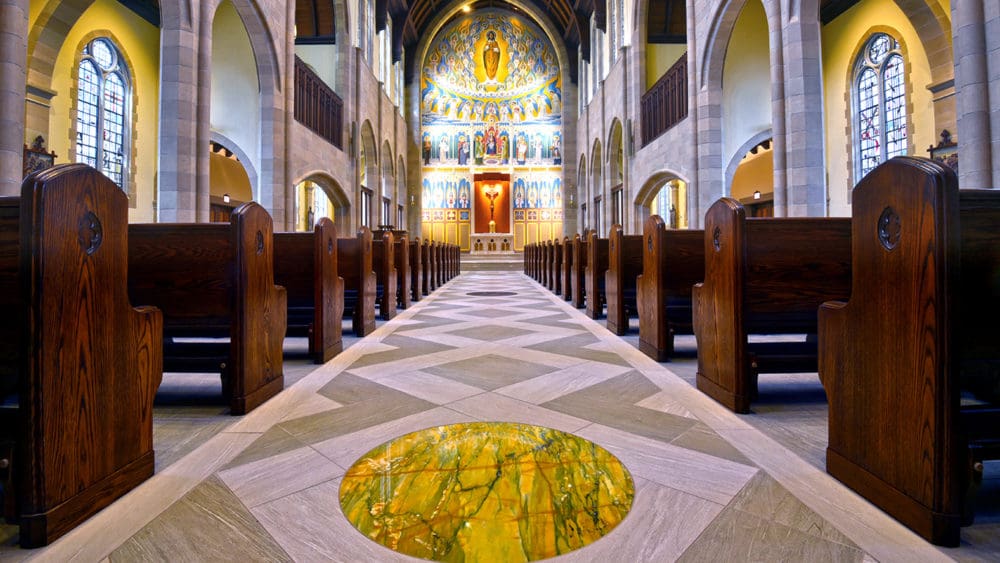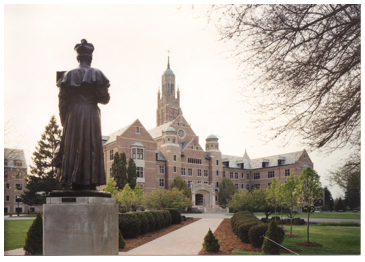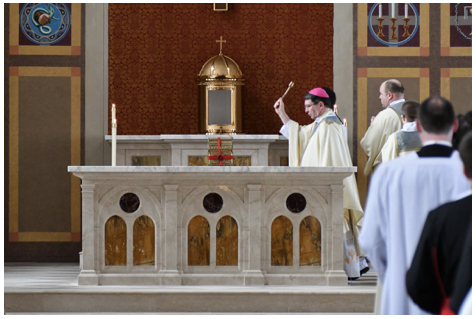Worship and Formation Find Their Place
The St. Turibius Chapel at the Pontifical College Josephinum was constructed in the early 1930s with the two-fold aim of providing a worthy place for the worship of God (Holy Mass and Divine Office) and for the spiritual, theological, and pastoral formation of future priests. When submitting his proposal for the construction of the Seminary, architect F.A. Ludewig noted in particular, “The Chapel has been given infinite study, that all Liturgical Essentials might be observed in its planning and furnishing. The result is one of simple splendor and refinement, as commodious as necessity demands yet in no way overstepping the limitations prescribed by economy.”
The Chapel speaks not empty chatter but a deep resonating dialogue. Whether through its architecture, windows or artwork, it presents symbols we must engage and to which we must respond.
Refinements were undertaken not long after the chapel was first opened. Reacting to the assessment of celebrated American architect Ralph Adams Cram (1863-1942), who suggested that the apsidal windows were disproportionate and out of place, a new program for the apse was undertaken that included the suppression of the windows. The seminary engaged artist Gerhard Lamers (1871-1964) to create an enormous mural of Christ the High Priest. In the view of the earliest witnesses, the result was breath-taking, as a Josephinum seminarian from 1936 notes, “Upon entering the chapel we thought for a moment that we had accidentally stumbled into paradise…. We saw Christ in all his glory, surrounded by the hosts of angels.”
The Second Vatican Council reiterated the profound insight in this anonymous seminarian’s reaction noting, “The practice of placing sacred images in churches so that they may be venerated by the faithful is to be maintained. Nevertheless their number should be moderate and their relative positions should reflect right order. For otherwise they may create confusion among the Christian people and foster devotion of doubtful orthodoxy” (Sacrosanctum Concilium, 125).
The physical weakening of brick and mortar over time, the resulting deterioration of the fresco, and a wave of iconoclasm led to a renovation in the 1980s that included the suppression of the mural.
Recently, under the direction of the Josephinum’s seminary administration, the architectural firm of William Heyer, and New York-based EverGreene Architectural Arts, a new vision, a growing appreciation for the place of art in sacred liturgy, and advances in technology have enabled the restoration of the chapel and the recreation of Lamers’s mural. The extensive work, including new walls, sanctuary, flooring and altar, necessitated the chapel’s rededication. On April 24, the Rite of Dedication was celebrated by Archbishop Christophe Pierre, Apostolic Nuncio to the United States and Chancellor of the Pontifical College Josephinum. That celebration inspired the remarks that follow.
A Symphony of Sacramental Signs
Catholic spirituality is inextricably bound up with sacramentality. Rooted in the doctrine of the incarnation, sacramental expression depends both on the ritual presentation of sensible signs, and the engagement of the intellect to associate the signs with their deeper, hidden meaning. (We do not discount faith, of course, which is the acknowledgement of our confidence that God does indeed communicate himself to his people in these mysteries.) Incarnation depends on a material creation.
Thus, St. John of Damascus, the great Syrian Doctor of the Church, can point out, “Previously God, who has neither a body nor a face, absolutely could not be represented by an image. But now that he has made himself visible in the flesh and has lived with men, I can make an image of what I have seen of God…and contemplate the glory of the Lord, his face unveiled.”i
The Eternal Word, taking on human flesh is a visible representation of the invisible God; thus, the mystery of the Incarnation is the pattern followed in other aspects of the sacramental mystery. The phenomenon is noted by St. Justin in the miracle of Holy Communion: “Some see common bread; we see the Lord; some see common wine; we drink the blood of Christ.”ii
Catholic liturgy is awash with similar themes, a most exquisite rendering of which is presented as the Church celebrates the Nativity of Christ: “For in the mystery of the Word made flesh a new light of your glory has shone upon the eyes of our mind, so that, as we recognize in him God made visible, we may be caught up through him in love of things invisible.”iii
It is through the visible, perceptible world, that we come to know the mysterious love of the God that we cannot see. What is required, however, is not simply the presentation of signs. There must be an initiation into these mysteries, so that participants learn how to recognize and read the signs. Those who do not know how to enter in may have an intuition, but they are limited in their capacity to benefit more fully from the sacramental exchange.
One is reminded of an episode in the story Babette’s Feast by Isak Dinesen in which one of the invitées to the great supper is presented a flute of champagne: “This is good,” she says. “Must be some kind of lemonade.” On one level she knows the beverage is tasty; she has the correct intuition, but she misses the great value of her degustation! Seated also at table is the seasoned participant General Löwenhielm. He discerns not lemonade, but the drink in its rich complexity: the famous Veuve Cliquot 1860! Not only can he name the vintner he can also name the vintage. Intelligent participation gives us access to the treasure contained therein.
Explaining how such access is possible in the liturgy, the Catechism of the Catholic Church reminds us, “A sacramental celebration is woven from signs and symbols. In keeping with the divine pedagogy of salvation, their meaning is rooted in the work of creation and in human culture, specified by the events of the Old Covenant and fully revealed in the person and work of Christ” (1145).
Behind liturgical intelligence is a narrative that links what we see, smell, hear, taste and touch to what we believe. That narrative, most appropriately (but not exclusively), is drawn from the sacred scriptures. The dedication of a church is one of the most exquisite examples of this dynamic at work.
Symbols are by nature multivalent, which means that there is rarely one-to-one correspondence between the visible sign and what it conveys. In baptism, for example, water means cleansing, but it also means death. These notions are woven together and co-exist serenely in the ritual prayer over the waters of baptism. The Catechism is quick to point to these different elements in the liturgy:
“A sacramental celebration is a meeting of God’s children with their Father, in Christ and the Holy Spirit; this meeting takes the form of a dialogue, through actions and words. Admittedly, the symbolic actions are already a language, but the Word of God and the response of faith have to accompany and give life to them, so that the seed of the Kingdom can bear its fruit in good soil. The liturgical actions signify what the Word of God expresses: both his free initiative and his people’s response of faith” (1153).
Likewise, in the rite of the dedication of a church, the different images (and there are many of them!) convey a variety of meanings without tension. While a treatment of the sacramental signs cannot be exhaustive, an introduction to some of them can whet the liturgical appetite and stimulate intellectual curiosity.
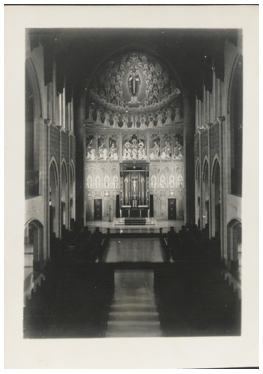
A Liturgical Context
The “Common of the Dedication of a Church” is the first of all Commons arranged in the Roman Missal and in the Liturgy of Hours. It precedes all others. This is not a coincidence. It is no slight to the Blessed Virgin Mary (whose common prayers are arranged in the second place), it does not compromise the value of the Apostles and Martyrs and Pastors who follow. They are all members of Christ’s own Body. The Blessed Mother is herself tabernacle and member of this Body. The church building is the sacramental sign of Christ’s mystical body.
There is no fluke in the Liturgical Calendar; therefore, it should come as no surprise that the anniversary of the dedication of a church is celebrated annually in each church as a solemnity. This church building is the visible sign of Christ’s continuing presence in the world, as the members of his mystical body are his hands and feet. This insight inspires St. Theresa of Avila, doctor of the Church, to her profound reflection of the mission of each Christian in the world:
Christ has no body now on earth but yours,
no hands but yours, no feet but yours,
Yours are the eyes through which to look out
Christ’s compassion to the world;
Yours are the feet with which he is to go about doing good;
Yours are the hands with which he is to bless men now.
At the promulgation of the Rite for the Dedication of a Church and Altar in 1977, then Prefect for Sacred Congregation for the Sacraments and Divine Worship, Cardinal James R. Knox noted that the rite “should be considered among the most solemn liturgical actions. For the place where the Christian community is gathered to hear the Word of God, to offer prayers of intercession and praise to God, and above all to celebrate the sacred mysteries and where the Most Holy Sacrament of the Eucharist is reserved is a special image of the Church, which is God’s temple built from living stones.” The rite itself goes on to teach that because the church is a visible building, it is sign both of the pilgrim Church on earth and an image of the Church dwelling in heaven. In this place, in a deliberate and profound way, heaven and earth are joined.
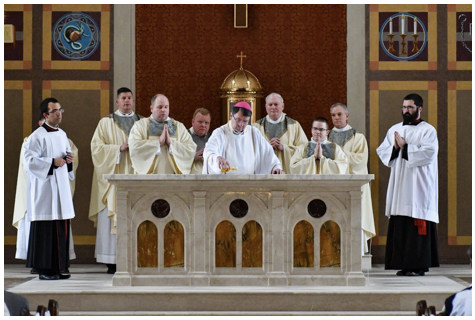
A Community. A Place. A Body
The dedication of a church is a momentous event in the life of a community. Because it is so significant and can be so powerful, this ritual is one that the Church has arranged with exceptional care. The rite is comprised of simple yet evocative signs informed by the sacred texts that accompany them.
The community meets at a certain time, in a pre-arranged place. There is a procession. It is not an aimless wandering, but a determined march to a destination. The procession forms. The cross of Christ is in the lead. No candles take part save those that honor the relics: the silent witness of the martyrs and saints. The ministers follow, then all the faithful. They sing “Let us go rejoicing to the house of the Lord.” It is interspersed with other verses from Psalm 122 (121), a psalm of David, a psalm of ascent to the encounter with God.
Arriving at the entrance of the church, the procession “halts” at the threshold.
The doors are locked. The lights are out. The place is empty.
Then there is a ceremonial opening of the doors, the handing over of the keys, a filing in of the members, two-by-two.
The greatest authority in the local community, the Bishop, invites the assembly to cross the threshold: “Enter the gates of the Lord with thanksgiving, his courts with songs of praise.”
Again the faithful join their voices. The Scriptures inspire the chant: “Grow higher, ancient doors, let him enter, the king of glory!” (Psalm 24).
All is still inside.
The only sound emanates from the naked human voices pushing through the doors. The only movement is that of the members assembling in their places.
The altar—if it can be called an altar at this point—is bare. Naked. Inanimate. The altaris ignored. (Just this one time.) The ministers walk by it without gesture, without sign of reverence, as if it were only a chunk of stone. (Just three months ago, this stone was entombed in the earth. Now, the natural stone resurrected and shaped by sweat and the skill of human hands will receive a supernatural status.) It will become, as Cardinal Knox notes, “a sign of Christ, who is the Priest, the Victim, and the Altar of his own Sacrifice.”
The Bishop gives the greeting of the Risen Christ: “Peace be with you.”
The Sprinkling of Holy Water follows. The prayer for the blessing of the holy water calls this sprinkling a cleansing with “the dew of charity.” The bishop passes through the church, sprinkling the people and the walls of the building: living stones and their image. He concludes this procession at the great stone (like the memorial stone in Israel’s desert, it is marker of the meeting with God), the altar. The bishop begins cleansing it with waters reminiscent of Baptism, the first part of a process that will initiate it into the symbol of Christ. (Washing now. Anointing, clothing, lighting, and Eucharistizing later.)
Meanwhile, the choir weaves together passages from the Book of the Prophet Ezekiel and the Book of Revelation, images of the life-giving water of creation and of the Passion of Christ, the true Temple. “I saw water flowing from the Temple, from its right-hand side, alleluia; and all to whom this water came we saved and shall say: Alleluia, alleluia.” The Christian temple is a New Eden. As Margaret Barker suggests, from this temple flows a “river which [brings] supernatural fertility.”iv
The scripture that inaugurates a newly constructed church is always taken from the Book of Nehemiah, chapter 8. It recounts how Ezra the scribe mounted a wooden platform “in the square in front of the Water Gate” to read to all the people from the Book of Moses.
Then the Psalm, the Epistle and the Gospel. Still no lights. Still no incense. A homily. The Creed. And then the great Litany of Intercession that implores God and begs the intercession of the Saints that this building will be “a house of salvation and grace,” as the prayer of dedication says.

And the Rock was Christ
Attention now moves intently to the altar. The first action at this point is the deposition of the relics. The relics are placed beneath the altar to signify that the sacrifice of the members has drawn its origin from the Sacrifice of the Head. St. Ambrose reminds the Church, “Let the triumphant victims occupy the place where Christ is victim: he, however, who suffered for all, upon the altar; they who have been redeemed by his sufferings, under the altar.” The short Psalm 15 (14) is intoned, “Lord, who may abide in your tent? Who may dwell on your holy mountain?” The answer is here: the blameless ones, the saints whose intercession we seek in the accompanying antiphon. “Beneath the altar of God you have been placed, O Saints of God: intercede for us before the Lord Jesus Christ.” Tertullian reminds us, too, “the souls of the martyrs under the altar cry out to the Lord: ‘O Sovereign Lord, holy and true, how long before you judge and avenge our blood on those who dwell upon the earth?’” v
The Sacred Chrism is poured out in five places on the altar, in a kind of quincunx pattern: in the center and on each of the four corners. With a surgeon’s precision and care, the Bishop anoints the surface of the mensa. The rite teaches us that “by the anointing with Chrism the altar is made a symbol of Christ.” He is the Anointed One, and like the anointed Christian at baptism, the anointed altar becomes “another Christ.”
In a reflection on Psalm 26, Augustine recalls the anointing that Christ and Christians share: “But not only was our Head anointed; his body was too, we ourselves. He is king because he reigns over us and leads us; priest because he intercedes on our behalf. What is more, he alone is priest in such a way as to be also the sacrifice. He offered to God a sacrifice that was nothing other than himself. He could not find a totally pure victim, endowed with reason, apart from himself. He is like a spotless lamb who redeemed us by his own spilt blood, uniting us into one body with himself and making us his members, so that in him we too are Christ. This is why anointing is proper to all Christians, even though in earlier times under the Old Covenant it was given to two kinds of persons only. For this it is obvious that we are the body of Christ, being all anointed. In him all of us belong to Christ, but we are Christ too, because in some sense the whole Christ is Head and body.”vi
The prayer that accompanies the anointing of the altar and the walls of the church (with the sign of the cross in 12 or four places) clearly indicates what these visible signs symbolize:
May the Lord by his power
sanctify this altar and this house,
which by our ministry we anoint,
so that as visible signs
they may express the mystery of Christ and the Church.vii
And then with Psalm 84 (83)—“How lovely is your dwelling place!”—the antiphon reminds us that by this anointing the church building, as the heart of the Christian becomes a tabernacle where God takes up his abode:
Behold God’s dwelling (tabernaculum) with the human race.
He will live with them
and they will be his people
and God himself with them will be their God.
Then incense is burned on the altar. Perhaps in a brazier, but the rite also allows for the burning of incense directly on the surface of the altar, as if to suggest the inseparable connection between the offering of incense and the immolation of Sacred Victim. Incense carries a variety of meanings: this complete offering of the victim, our prayers rising to heaven, and also the veil that shrouds the ineffable mystery. The Rite itself teaches that “Incense is burned on the altar to signify that the Sacrifice of Christ, which is there perpetuated in mystery, ascends to God as an odor of sweetness; this is also a sign that the pleasing and acceptable prayers of the faithful rise up to the throne of God.”viii
The intervention of the bishop at this point draws from both the Old and New Testaments: first from Psalm 141 (140)—that our prayers rise like incense—and Second Corinthians, chapter 2, where St. Paul insists that we are the aroma of Christ.
Let our prayers rise, O Lord,
like incense in your sight;
and as this house is filled with a pleasing fragrance
so let your Church be fragrant with the aroma of Christ.
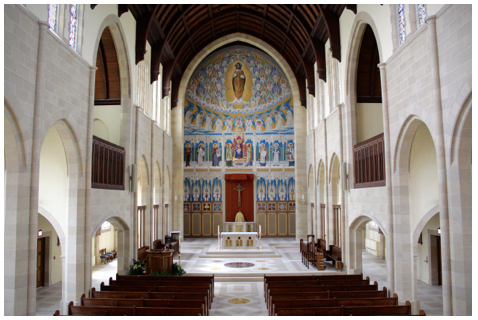
Cleaned and Clothed and Lighted
When the anointing and the burning of incense have been accomplished, the altar is wiped clean and clothed with a white linen. Nothing is said during this time. Perhaps we are meant simply to marvel at the parallel between the washing, anointing and clothing of the altar and the same ritual gestures that occur in the sacrament of Baptism.
The lighting of the church has been delayed to this moment. The majority of the dedication rites having been completed, the Bishop passes a lighted taper to the Deacon, instructing him to light all the candles of the altar and church:
Let the light of Christ shine brightly in the Church,
that all nations may attain the fullness of truth.
The Church is explicit in what she means to symbolize by the lighting of candles: “The lighting of the altar, which is followed by the lighting of the church, reminds us that Christ is ‘a light for revelation to the Gentiles,’ whose brightness shines out in the Church and through her upon the whole human family.”ix
Meanwhile, all the lights in the church are illuminated and the choir sings the Canticle of Tobit (chapter 13), which both praises God for his glory, but also sings of the new and ideal Jerusalem, of which the Church is the image.
Give thanks to the Lord with righteousness,
and bless the King of the ages,
so that your tabernacle may be rebuilt in you with joy.
Jerusalem, city of God, you will shine with splendid light.[…]
A bright light will shine to the limits of the earth.
The Mass of Dedication continues with the Liturgy of the Eucharist and while there are few additions to this part of the Mass, the Order of Dedication makes it clear that the only real essential rite for dedication is the celebration of the Eucharist itself: “The celebration of the Eucharist is the most important rite, and the only necessary one, for the dedication of a church. Nevertheless, in accordance with the common tradition of the Church, both East and West, a special Prayer of Dedication is also said, by which the intention of dedicating the church to the Lord for all time is signified and his blessing is implored.”x
The rite of dedication gives a further reflection, calling on the Tradition of the Church Fathers, especially St. John Chrysostom: “The Eucharist, which sanctifies the hearts of those who receive it, in a sense consecrates the altar and the place of celebration, as the early Fathers of the Church assert more than once: ‘This altar is an object of wonder: by nature it is stone, but it is made holy after it receives the Body of Christ.’”xi
St. Augustine thinks of the Lord’s house not as a building, but rather as a company of people, those united with the Lord in faith and charity. Thus in his commentary on Psalm 26 he says, “one single petition I have made to the Lord, and that one I shall pursue: to live in the Lord’s house all the days of my life, so that as long as I am in this life, no adversity may estrange me from the company of those who uphold the unity and truth of faith in the Lord, all the world over.”xii
For Augustine, the Christian becomes the Lord’s temple: “When death has been swallowed up in victory I shall be clothed in immortality, being made his temple.”xiii The Order of the Dedication of a Church brings together the various images and presents to the Christian faithful a series of images that demonstrate how the church building is an image of the community of the church, which in turn, as Christ’s Mystical Body, denotes his visible presence on earth. These images are summarized in the great prayer of dedication: “Here is reflected the mystery of the Church.”
The Church Building is Christ
The future publication of a new translation of the Order of the Dedication of a Church gives us an opportunity to explore the richness of the liturgical rites and texts. In every instance, they reinforce Prosper of Aquitaine’s maxim: lex orandi, lex credendi. If you want to know what the Church believes, pay attention to what she says when she prays.
1 St. John Damascene, De imag. 1, 16: PG 96: 1245-1248.
2 Justin, I Apol. 66.
3 Roman Missal, Preface I of the Nativity of the Lord.
4 Margaret Barker, The Gate of Heaven. The History and Symbolism of the Temple in Jerusalem, Sheffield Phoenix Press, 2008, p. 69.
5 Tertullian, De orat. 5: PL 1,1159A.
6 Augustine, Expostitions of the Psalms, vol, III/15, Hyde Park, NY: New City Press, 2000, p. 274-275.
7 This and all other excerpts from the Order of the Dedication of a Church are prepared by ICEL and taken from the future second edition, presently still in draft form.
8 Order of the Dedication of a Church, 16.
9 Order of the Dedication of a Church, 16.
10 Order of the Dedication of a Church, 15.
11 Order of the Dedication of a Church, 16.
12 Augustine, Expostitions of the Psalms, vol, III/15, Hyde Park, NY: New City Press, 2000, p. 271.
13 Augustine, Expostitions of the Psalms, vol, III/15, Hyde Park, NY: New City Press, 2000, p. 271.
